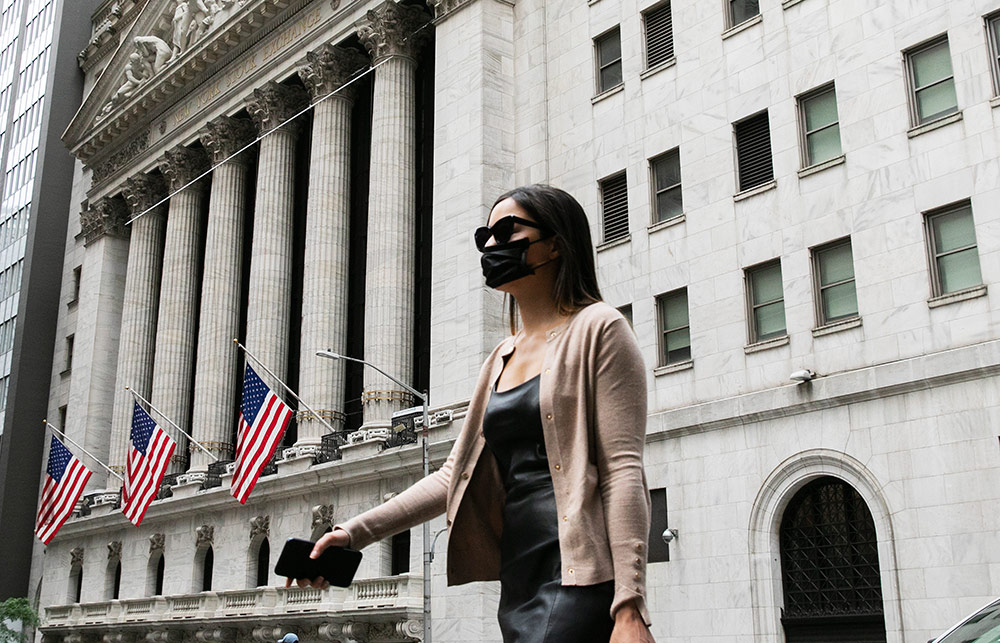周二,华尔街用一轮上涨结束了自1998年以来业绩最好的一个季度。在令投资者惊叹不已的这三个月里,美股从暴跌之后迅速反弹回到历史高点。
标普500指数上涨1.5%,季度涨幅接近20%。今年前三个月,标普500指数下跌20%,是其自2008年金融危机以来最糟糕的一个季度。新冠疫情导致停工和成百上千万人失业,是导致股市暴跌的罪魁祸首。
Baird公司的投资策略师威利•德尔维彻说:“这是自20世纪30年代以来第一次出现相邻两个季度大涨大跌的行情。这是史无前例的。”

美国股市在第二季度的高歌猛进,是因为投资者没有受到可怕的失业数据的影响,并且他们日益希望经济能够相对较快地走出突如其来的严重衰退。这种希望似乎很有预见性,因为上一季度的报告显示,各地政府正在逐步放松旨在抑制新冠病毒传播的封锁令,因此雇主开始恢复招聘,零售销售也出现了反弹。
美联储和美国国会承诺拿出大量救助资金,引燃了第二季度股市上涨的行情。低利率通常会促使投资者从低收益的债券转向投资股票,而美联储已经将短期利率下调至接近零的历史新低。
但华尔街的大部分人都表示,不要指望第二季度的暴涨行情能够重复。感染人数的持续增长已经迫使多个州暂停解除限制令。由于美国确诊病例激增,因此欧盟已经禁止美国游客入境,这不禁让人怀疑美国经济是否会像市场预期的那样迅速复苏。这也解释了为什么6月市场的增长势头会有所降温。
周二,美国首席传染病专家安东尼•福奇博士警告,如果美国民众不从现在开始遵从公共卫生建议,每日新报告感染病例可能激增到10万例。
除了新冠疫情以外,分析师还指出即将到来的美国大选和其他风险可能让市场陷入低迷。许多投资者认为民主党有可能在国会选举和总统大选中大获全胜。如果这种假设成真,则意味着税率将提高,从而压缩企业的利润。
周二,标普500指数上涨47.05点至3,100.29点。道琼斯工业平均指数上涨217.08点至25,812.88点,涨幅0.9%。期间还曾短暂下跌120点。纳斯达克综合指数上涨184.61点至10,058.77点,涨幅1.9%。
标普500指数在3月末下跌近34%,如今距离2月的历史最高点只相差不到8.4%。本月初,标普500指数一度上涨近4.5%。
周五,美股上涨的主力是科技股、医疗股和金融股。有报告称本月消费者信心增长势头远超预期,消息传出后,投资者大举买入。
Northwestern Mutual Wealth Management公司的首席投资策略师布伦特•舒特表示:“总体上来说,市场在对超出预期的经济数据做出反应。”
舒特指出,美国可能不会出现全国性停工、激进的货币政策和对疫苗更快问世的期望,支撑着市场的走势。他说:“最省力的方法依旧是向前走两步,后退一步。”
第二季度,科技股依旧稳健,涨幅达到27.6%,仅次于非必需消费品行业(上涨30.2%)。第一季度遭遇重创的航空公司和邮轮运营商的交易非常动荡。
苹果公司依旧是标普500指数中最有价值的公司,第二季度股价上涨43.5%,美国航空公司第二季度上涨7.2%,皇家加勒比邮轮公司的股价上涨了56.4%。当然,这些公司的股票同比依旧下跌了近60%。
第二季度,原油价格也出现了与股市类似的反弹,但依旧远低于疫情之前的水平。能源公司强势回归,第二季度标普500指数涨幅最大的公司包括阿帕奇、哈里伯顿和马拉松石油公司。
周二,每桶美国原油的价格下跌43美分至39.27美元,但与第一季度末相比依旧上涨了近一倍。这与4月也有着天壤之别,当时,由于市场担心需求骤降将导致无处存放未使用的石油,使美国原油市场部分石油的价格一度跌至0美元以下。布伦特原油价格下跌56美分至每桶41.15美元。
周一晚些时候,美国10年期国债收益率从0.63%提高到0.66%,也已经从投资者最担心经济衰退时的低点有所反弹。据Tradeweb显示,美国10年期国债收益率在3月创下历史新低,一度跌至0.50%以下。其收益率通常会随着投资者对经济和通货膨胀的预期发生变化。
欧洲股市的表现喜忧参半,而亚洲股市出现上涨。(财富中文网)
翻译:刘进龙
审校:汪皓
周二,华尔街用一轮上涨结束了自1998年以来业绩最好的一个季度。在令投资者惊叹不已的这三个月里,美股从暴跌之后迅速反弹回到历史高点。
标普500指数上涨1.5%,季度涨幅接近20%。今年前三个月,标普500指数下跌20%,是其自2008年金融危机以来最糟糕的一个季度。新冠疫情导致停工和成百上千万人失业,是导致股市暴跌的罪魁祸首。
Baird公司的投资策略师威利•德尔维彻说:“这是自20世纪30年代以来第一次出现相邻两个季度大涨大跌的行情。这是史无前例的。”
美国股市在第二季度的高歌猛进,是因为投资者没有受到可怕的失业数据的影响,并且他们日益希望经济能够相对较快地走出突如其来的严重衰退。这种希望似乎很有预见性,因为上一季度的报告显示,各地政府正在逐步放松旨在抑制新冠病毒传播的封锁令,因此雇主开始恢复招聘,零售销售也出现了反弹。
美联储和美国国会承诺拿出大量救助资金,引燃了第二季度股市上涨的行情。低利率通常会促使投资者从低收益的债券转向投资股票,而美联储已经将短期利率下调至接近零的历史新低。
但华尔街的大部分人都表示,不要指望第二季度的暴涨行情能够重复。感染人数的持续增长已经迫使多个州暂停解除限制令。由于美国确诊病例激增,因此欧盟已经禁止美国游客入境,这不禁让人怀疑美国经济是否会像市场预期的那样迅速复苏。这也解释了为什么6月市场的增长势头会有所降温。
周二,美国首席传染病专家安东尼•福奇博士警告,如果美国民众不从现在开始遵从公共卫生建议,每日新报告感染病例可能激增到10万例。
除了新冠疫情以外,分析师还指出即将到来的美国大选和其他风险可能让市场陷入低迷。许多投资者认为民主党有可能在国会选举和总统大选中大获全胜。如果这种假设成真,则意味着税率将提高,从而压缩企业的利润。
周二,标普500指数上涨47.05点至3,100.29点。道琼斯工业平均指数上涨217.08点至25,812.88点,涨幅0.9%。期间还曾短暂下跌120点。纳斯达克综合指数上涨184.61点至10,058.77点,涨幅1.9%。
标普500指数在3月末下跌近34%,如今距离2月的历史最高点只相差不到8.4%。本月初,标普500指数一度上涨近4.5%。
周五,美股上涨的主力是科技股、医疗股和金融股。有报告称本月消费者信心增长势头远超预期,消息传出后,投资者大举买入。
Northwestern Mutual Wealth Management公司的首席投资策略师布伦特•舒特表示:“总体上来说,市场在对超出预期的经济数据做出反应。”
舒特指出,美国可能不会出现全国性停工、激进的货币政策和对疫苗更快问世的期望,支撑着市场的走势。他说:“最省力的方法依旧是向前走两步,后退一步。”
第二季度,科技股依旧稳健,涨幅达到27.6%,仅次于非必需消费品行业(上涨30.2%)。第一季度遭遇重创的航空公司和邮轮运营商的交易非常动荡。
苹果公司依旧是标普500指数中最有价值的公司,第二季度股价上涨43.5%,美国航空公司第二季度上涨7.2%,皇家加勒比邮轮公司的股价上涨了56.4%。当然,这些公司的股票同比依旧下跌了近60%。
第二季度,原油价格也出现了与股市类似的反弹,但依旧远低于疫情之前的水平。能源公司强势回归,第二季度标普500指数涨幅最大的公司包括阿帕奇、哈里伯顿和马拉松石油公司。
周二,每桶美国原油的价格下跌43美分至39.27美元,但与第一季度末相比依旧上涨了近一倍。这与4月也有着天壤之别,当时,由于市场担心需求骤降将导致无处存放未使用的石油,使美国原油市场部分石油的价格一度跌至0美元以下。布伦特原油价格下跌56美分至每桶41.15美元。
周一晚些时候,美国10年期国债收益率从0.63%提高到0.66%,也已经从投资者最担心经济衰退时的低点有所反弹。据Tradeweb显示,美国10年期国债收益率在3月创下历史新低,一度跌至0.50%以下。其收益率通常会随着投资者对经济和通货膨胀的预期发生变化。
欧洲股市的表现喜忧参半,而亚洲股市出现上涨。(财富中文网)
翻译:刘进龙
审校:汪皓
Wall Street capped its best quarter since 1998 Tuesday with more gains, a fitting end to a stunning three months for investors as the market screamed back toward its record heights after a torrid plunge.
The S&P 500 climbed 1.5%, bringing its gain for the quarter to nearly 20%. That rebound followed a 20% drop in the first three months of the year, the market's worst quarter since the 2008 financial crisis. The plunge came as the coronavirus pandemic ground the economy to a halt and millions of people lost their jobs.
“It's the first time you've had back-to-back (quarters) like this since the 1930s,” said Willie Delwiche, investment strategist at Baird. “It's pretty unprecedented.”
The whiplash that ripped through markets in the second quarter came as investors looked beyond dire unemployment numbers and became increasingly hopeful that the economy can pull out of its severe, sudden recession relatively quickly. The hopes looked prescient after reports during the quarter showed that employers resumed hiring again and retail sales rebounded as governments relaxed lockdown orders meant to slow the spread of the coronavirus.
The quarter’s gains were ignited by promises of massive amounts of aid from the Federal Reserve and Congress. Low interest rates generally push investors toward stocks and away from the low payments made by bonds, and the Federal Reserve has pinned short-term interest rates at their record low of nearly zero.
But most of Wall Street says not to expect anything close to a repeat of the rocking second quarter. A rise in infections has several states pausing their lifting of restrictions. The surge in confirmed new cases, which has prompted the European Union to bar U.S. travelers from entry, is seeding doubts that the economic recovery can happen as quickly as markets had forecast. That helps explain why the market’s momentum cooled somewhat in June.
On Tuesday Dr. Anthony Fauci, the nation’s top infectious-disease expert, warned that the number of daily new reported infections could surge to 100,000 if Americans don’t start following public health recommendations.
Beyond the coronavirus, analysts also point to the upcoming U.S. elections and other risks that could upset markets. If Democrats sweep Congress and the White House, which many investors see as at least possible, it could mean higher tax rates, which could weaken corporate profits.
The S&P 500 gained 47.05 points to 3,100.29 on Tuesday. The Dow Jones Industrial Average rose 217.08 points, or 0.9%, to 25,812.88. It had briefly been down 120 points. The Nasdaq composite climbed 184.61 points, or 1.9%, to 10,058.77.
The S&P 500 has rallied back to within nearly 8.4% of its record set in February, after being down nearly 34% in late March. At one point earlier this month, it had climbed as close as 4.5%.
Technology, health care and financial companies powered much of the market’s broad gains Friday. The buying accelerated after a report showed stronger-than-expected improvement in consumer confidence this month.
“Broadly speaking, the market is reacting to economic data that is better than expected,” said Brent Schutte, chief investment strategist at Northwestern Mutual Wealth Management.
Schutte said the market is being supported by the likelihood that there won’t be a nationwide shutdown again, aggressive monetary policy and hopes for a vaccine sooner rather than later. “The path of least resistance is still two steps forward, one step back,” he said.
The quarter featured steady gains in technology stocks, which climbed 27.6%, second only to the consumer discretionary sector's 30.2% gain. And airlines and cruise operators traded wildly after being battered for much of the first quarter.
Apple, once again the most valuable company in the S&P 500, gained 43.5% for the second quarter, American Airlines climbed 7.2% for the quarter, while Royal Caribbean Cruises vaulted 56.4%. Still, they each remain down nearly 60% for the year.
Crude oil had a similar rebound as stocks through the second quarter, though it’s still well below where it was before the pandemic struck. Energy companies mounted a solid comeback, with three of them — Apache, Halliburton and Marathon Oil — showing the biggest percentage gains in the S&P 500 for the quarter.
A barrel of U.S. crude oil slid 43 cents to settle at $39.27 Tuesday, but it’s still nearly double where it was at the end of the first quarter. It’s also in a different world from April, when prices in one corner of the U.S. crude market briefly went below zero amid worries that collapsing demand would leave nowhere to store all the unused oil. Brent crude oil fell 56 cents to settle at $41.15 a barrel.
The yield on the 10-year Treasury rose to 0.66% from 0.63% late Monday. It too has rallied back from its lows when recession worries were at their height. It set a record low in March when it briefly dipped below 0.50%, according to Tradeweb. The yield tends to move with investors' expectations for the economy and inflation.
European stocks closed mixed, and Asian markets finished higher.






